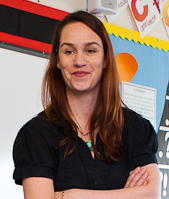 This post was contributed by Professor Jean-Marc Dewaele of Birkbeck’s Department of Applied Linguistics and Communications.
This post was contributed by Professor Jean-Marc Dewaele of Birkbeck’s Department of Applied Linguistics and Communications.
“Putain putain, c’est vachement bien, nous sommes quand même tous des Européens” (“Fuck, fuck, it’s really good, aren’t we all Europeans after all?”) was the chorus from an outrageous and hilarious French-Dutch-English song by the Belgian artist Arno that all (adult) students of the Advanced French class were belting out, heading towards the door at 9pm on a Friday in Brussels in the late 1980s. As their teacher, I was quite amazed by the level of enthusiasm that the song had generated: a perfect ending for an evening class. I will never forget what happened next. As I pulled the door open wide with a theatrical bow, the school director, who must have been leaning against the door listening to the racket inside, fell flat on the floor, got up blushing, and congratulated me meekly for a good classroom atmosphere and mumbled something about the appropriateness of the song. Students burst out laughing, and headed home singing and yelling. (Arno has produced more melodious songs such as “Les filles du bord de mer”, and the striking English song “Oh la la la” as singer in the Flemish group TC Matic. He was born in Ostend, has a strong Western Flemish accent in Dutch, and sings in equally accented French and English.)
This little episode from the first year of my teaching career is a nice illustration of the concept of “flow” (in that case rather “overflow”). Flow is the mental state of operation when people perform an activity in which they are so fully immersed and involved, with such focus and enjoyment, that they forget everything around them. When members of a group reach a state of flow they experience spontaneous joy and it strengthens bonds with other group members. It is described as the ultimate experience in harnessing the emotions in the service of performing and learning.
The point I want to make is that learners’ emotions are like wild horses (or at least, ponies). Learners can, with a little dexterity, and with a little help from teachers, harness the power of their emotions to absorb more of the foreign language and the culture.
 One of the main problems of foreign language (FL) teaching is that the emotional component is too often ignored, resulting in relatively emotion-free (and therefore often boring) classroom sessions. It is undoubtedly easier for curriculum designers and teachers to focus on rigid learning activities that require little emotional investment and therefore little potential for unpredictability, outbursts, surprise, risk-taking, embarrassment, anxiety … and enjoyment.
One of the main problems of foreign language (FL) teaching is that the emotional component is too often ignored, resulting in relatively emotion-free (and therefore often boring) classroom sessions. It is undoubtedly easier for curriculum designers and teachers to focus on rigid learning activities that require little emotional investment and therefore little potential for unpredictability, outbursts, surprise, risk-taking, embarrassment, anxiety … and enjoyment.
In fact, it is my strong belief that by trying to play it safe, curriculum designers and teachers got the wrong end of the stick. Teachers need the liberty to do unexpected, challenging and funny things. Routine is a killer in the classroom.
There is no doubt that teachers play a central role in establishing a positive learning environment. The progress of the learner is linked to the chemistry that develops between the learner, the other members of the group, and the teacher. Pertinent and appealing subject matters combined with non-threatening techniques create a positive language learning experience, support and promote group solidarity, boost motivation and lower levels of FL anxiety in the classroom.
Gregersen and MacIntyre, inspired by the Positive Psychology movement, explain that negative emotions are not always bad, as they can help learners to eliminate an obstacle but they can be paralysing. Positive emotions on the other hand “can broaden the field of attention and build resources for the future” and help learners “to build relationships, personal strength, and tolerances for the moments when things become difficult”.
In a recent study with the Canadian psychologist Peter MacIntyre, we considered the relationship between FL Enjoyment (FLE) and FL Classroom Anxiety (FLCA) among 1,746 FL learners from around the world. We found that both dimensions were negatively correlated, but that the amount of shared variance was relatively small. In other words, learners reporting higher levels FLE experienced less FLCA, although some did score high, or low, on both dimensions. To our relief, we discovered that levels of FLE were significantly higher than those of FLCA. The difference between levels of FLE and FLCA was relatively small for beginning learners, but widened for more advanced learners. In other words, as learners progress, their FL anxiety weakens and their enjoyment grows. It is thus crucial not to give up FL classes too early. Interestingly, female participants (who scored significantly higher on self-reported proficiency in the FL) reported both significantly more FLE and more FLCA. It thus seems that emotions (both positive and negative) are the driving force behind FL learning. “Putain putain, c’est vachement bien”, if you forgive my French.
Further reading:
- Arnold, J. (2011). Attention to affect in language learning. Anglistik. International Journal of English Studies, 22, 11-22.
- Csikszentmihalyi, M. (1990). Flow: The Psychology of Optimal Experience. Harper & Row.
- Dewaele, J.-M. (2011). Reflections on the emotional and psychological aspects of foreign language learning and use. Anglistik. International Journal of English Studies, 22, 23-42.
- Dewaele, J.-M., & MacIntyre, P.D. (2014). The two faces of Janus? Anxiety and enjoyment in the foreign language classroom. Studies in Second Language Learning and Teaching, 4, 237-274. doi: 10.14746/ssllt.2014.4.2.5
- Gregersen, T., & MacIntyre, P.D. (2014). Capitalizing on Individual Differences: From Premise to Practice. Bristol: Multilingual Matters.
Other posts by Professor Dewaele:
- “Most obscene article of a peer-reviewed scientific article” – an amusing award for a serious academic paper
- Multilingualism in psychotherapy
- Pardon my foreign accent!
- Why “younger” is not always “better” in foreign language learning
Other blogs about linguistics:
- Exploring Intercultural Communication: Language in Action, by Professor Zhù Hua
- What the **** is linguistics?, by Professor Penelope Gardner-Chloros

 Counter-intuitively, research suggests that adolescents and adults progress more quickly than children when learning FLs in a school context (so-called “instructed FL learning”). Many researchers have serious doubts about age of onset being the most important variable in successful FL learning. Indeed, research shows quite clearly that starting age is only one of many independent variables in very complex question.
Counter-intuitively, research suggests that adolescents and adults progress more quickly than children when learning FLs in a school context (so-called “instructed FL learning”). Many researchers have serious doubts about age of onset being the most important variable in successful FL learning. Indeed, research shows quite clearly that starting age is only one of many independent variables in very complex question. While increasing maternal age, especially for women from their mid to late 30s onwards, is linked to the likelihood of more medical risks for mother and infant, recently published research by my team at Birkbeck, with colleagues at UCL, indicate that this change to older motherhood could lead nationally to better child health and development, and to fewer parenting problems. The studies, based on two large samples – the Millennium Cohort Study and the National Evaluation of Sure Start – found that:
While increasing maternal age, especially for women from their mid to late 30s onwards, is linked to the likelihood of more medical risks for mother and infant, recently published research by my team at Birkbeck, with colleagues at UCL, indicate that this change to older motherhood could lead nationally to better child health and development, and to fewer parenting problems. The studies, based on two large samples – the Millennium Cohort Study and the National Evaluation of Sure Start – found that: